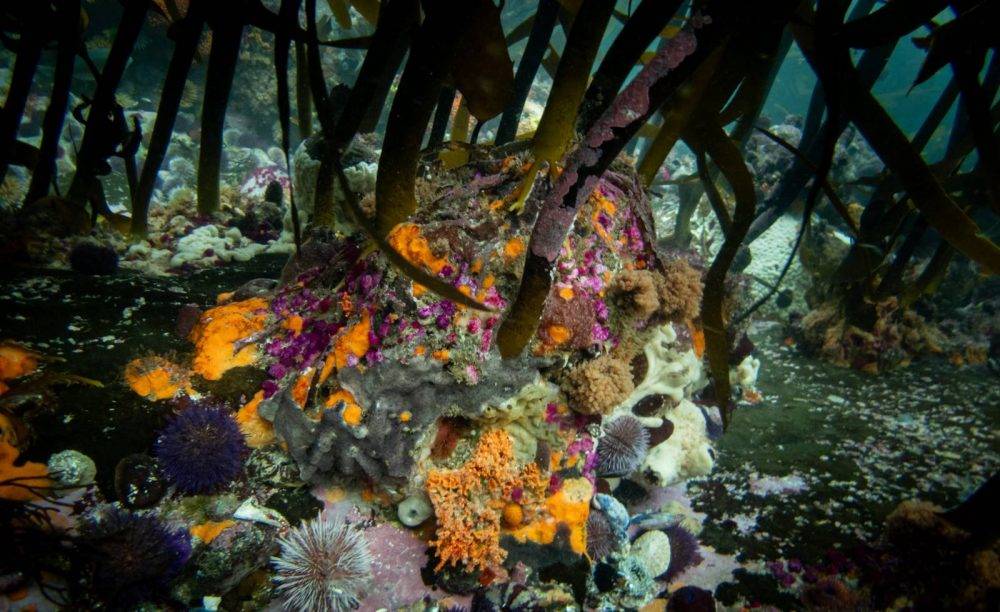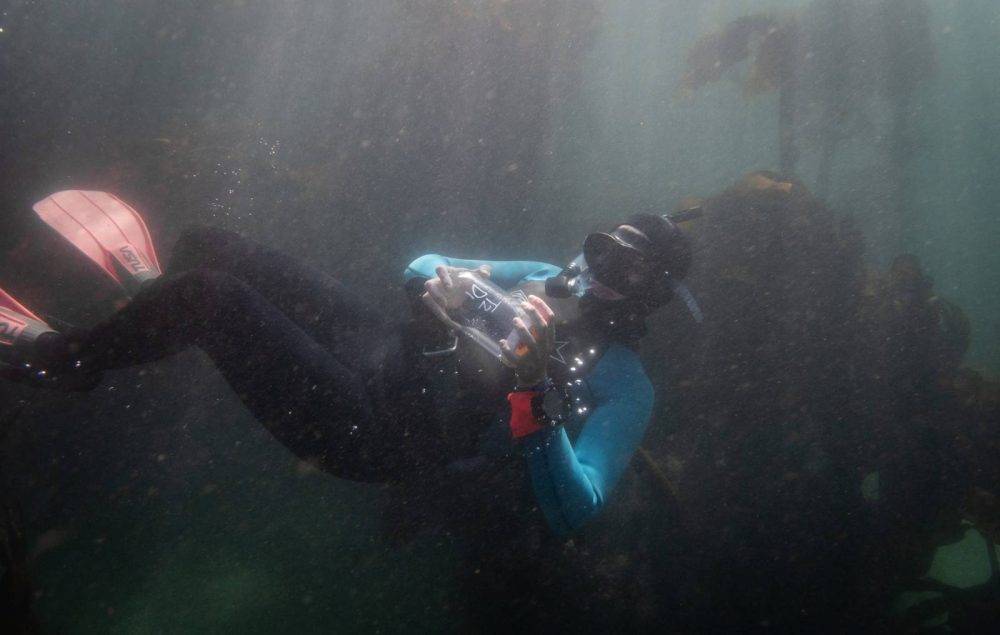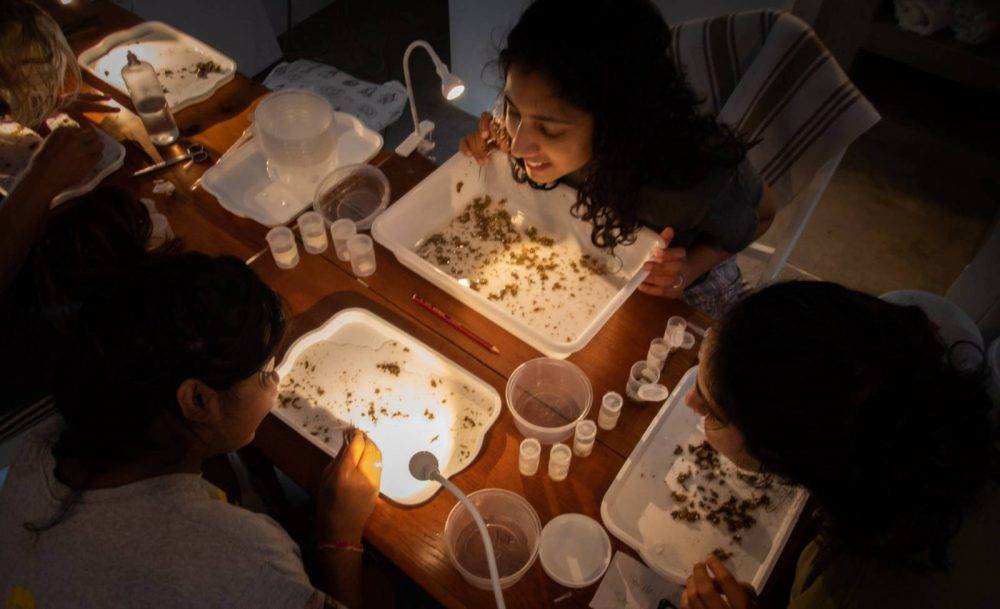The Great African Seaforest is a unique large-scale marine ecosystem that covers about 1000 kilometres of the South African coast line. Photo: Jannes Landschoff
Diving in False Bay’s kelp forests is like a love affair for marine biologist Jannes Landschoff.
The kelp forests are part of the Great African Seaforest, a unique marine ecosystem that ruffles the shores of Cape Town and stretches north for more than 1 000km to Namibia, and was home to the Oscar-winning documentary film My Octopus Teacher.
The Great African Seaforest is the only forest of giant bamboo kelp on Earth, “harbouring other-worldly creatures, startling abundance and rich biodiversity”, according to the Sea Change Project, a nonprofit environmental storytelling organisation in Cape Town. So much of this aquatic forest and its inhabitants have never been studied and “it’s not uncommon to find new species or new animal behaviours daily”, it said.
For Landschoff, who dives almost every day, there’s an enchanting and intricate beauty to the ecosystem of these sea forests.
“There are days like now where it’s rough and stormy … so there’s obviously this beauty to it but then there is, like, another layer and another layer and another layer of other species and food webs and what is actually eating what and figuring that over time,” he said. “It’s just fascinating. It is a love story really, because one constantly falls in love with this environment and the animals that live in there.”
Landschoff, a research associate at Stellenbosch University’s department of botany and zoology, leads Sea Change’s 1001 Seaforest Species project, which aims to document the distinctive species living in South Africa’s kelp forests. Funded by the Save Our Seas Foundation, the project blends scientific research and storytelling.
 Holdfasts of the Bamboo kelp Ecklonia maxima provide a habitat for diverse and understudied invertebrate communities. Photo: Jannes Landschoff
Holdfasts of the Bamboo kelp Ecklonia maxima provide a habitat for diverse and understudied invertebrate communities. Photo: Jannes Landschoff
“Together with Sea Change co-founder and filmmaker Craig Foster I dive the Great African Seaforest to uncover and share 1001 stories of the unique species that live there,” he said. “We combine marine biological research with the art of underwater tracking and storytelling … to inspire a renewed appreciation for the wonder and fragility of this special ecosystem.”
A recent memorandum of understanding between marine researchers at Stellenbosch University and the Sea Change Project has formalised a two-year working relationship and several student research projects on kelp forest ecosystems will be supported.
Biodiversity and ecology research in this field has dwindled since the 1970s, the researchers said in a statement. “Despite these forests being recognised for their intrinsic socio-ecological value, large knowledge gaps on the biodiversity they hold still exist.”
Because all marine ecosystems are under threat from climate change and human-caused pressures, it is “crucial to understand not only which species live where, but also their interactions with each other”, the researchers said.
The two institutions are working together to fill these knowledge gaps by not only recording their biodiversity but also by investigating the processes that have allowed kelp forests to become such biodiverse spaces.
South Africa’s kelp forests are a “national treasure” that needs awareness, knowledge and investment to unlock its full potential for society, said Landschoff.
“I think it’s difficult for people to imagine what’s actually down there. For many years, no one has really seen it and I think that’s changing … through our work and also through all the people who are diving and doing this sort of work.”
Landschoff said that taxonomy — the science of naming, describing and classifying species — is becoming more difficult because South Africa hasn’t developed this expertise. “So, for a lot of things [in the kelp forests] we don’t actually know what the animals are. I don’t think I’ll be able to do it in my lifetime.”
At Stellenbosch University, students undertaking the research are co-supervised by Nasreen Peer, a marine biologist and lecturer in the department of botany and biology, and Sophie von der Heyden, a marine molecular ecologist in the department of botany and zoology and School of Climate Studies, together with Landschoff.
The university’s scientists are working with Sea Change on two projects: the first is a taxonomic investigation of the biodiversity in kelp holdfasts, which Peer is leading, and a further investigation of large-scale patterns of kelp-associated biodiversity using DNA-based molecular tools, led by Von der Heyden.
The holdfasts of kelp are root-like structures that anchor the kelp to rocks, helping them to weather turbulent conditions such as the winter storms that hit the Cape.
Peer and Landschoff had long wondered if the network of sturdy holdfasts offered a shelter to animals, and devised student projects to study the invertebrate biodiversity in them. BSc Honours students Chaitanya Katharoyan and Jean-Pierre Joubert’s work on holdfasts has shown that these micro-habitats are teeming with life.
 Stellenbosch University MSc student Kira Courtaillac snorkelling in shallow waters of False Bay during eDNA sampling. Photo: Jannes Landschoff
Stellenbosch University MSc student Kira Courtaillac snorkelling in shallow waters of False Bay during eDNA sampling. Photo: Jannes Landschoff
In just one holdfast, they found more than 50 species of small crustaceans – that’s not even counting the array of sponges, worms and other animals that also make holdfasts their home.
“Even though we expected large numbers of species from the start, two years later, each holdfast sample still leaves us astounded at the new and wonderful things we find,” Peer said in a statement. “It’s a testament to the life and colour, often hidden or small in size, that keeps our planet going.
Given the scale of the findings, a new cohort of students will continue this work this year.
Complementing the taxonomic holdfast project, Von der Heyden’s students have been using DNA-based tools to provide genetic clues about species in the kelp forest.
Organisms shed DNA into their environment termed environmental DNA (eDNA).
By sequencing the eDNA filtered from a single sample of seawater, the team can identify entire marine communities from the genetic signatures they leave behind.
“Environmental DNA metabarcoding provides a powerful tool for detecting marine biodiversity, ranging from single-celled species to sharks,” Von der Heyden said. “With repeated sampling we can build an entire inventory of marine life from just a few litres of water, without needing to disturb the ecosystem.”
BSc Honours student Emma Rossouw, who analysed the eDNA in seawater samples from a single kelp forest site in False Bay, found more than 900 species representing almost 100 different taxonomic families. MSc student Kira Courtaillac is continuing this work.
The group plans to expand their partnership further into molecular ecology studies by building a genetic barcode library of invertebrate kelp forest species. The researchers said that by enabling DNA samples retrieved to be matched to sequences of known organisms in the reference library will open the door to further molecular studies in the ecosystem.
“Knowing which species live where and when is crucial to designing conservation actions, which makes eDNA metabarcoding an important tool in our conservation toolbox,” said Von der Heyden.
 Chaitanya Katharoyan is sorting through large numbers of invertebrates sampled from kelp holdfasts, together with her study leader Dr Nasreen Peer and 2022 research intern of the 1001 Seaforest Species project Zara Prew. Photo: Jannes Landschoff
Chaitanya Katharoyan is sorting through large numbers of invertebrates sampled from kelp holdfasts, together with her study leader Dr Nasreen Peer and 2022 research intern of the 1001 Seaforest Species project Zara Prew. Photo: Jannes Landschoff
While many kelp forests are shrinking, shifting and in numerous cases, even vanishing, the Great African Seaforest is thought to be growing, the Sea Change Project said.
In South Africa, coastal marine ecosystems face multiple pressures from human-driven changes, including climate change, ocean acidification and rising temperatures. Localised problems on the Cape Peninsula, include littering, marine plastic and sewage pollution in, said Landschoff.
“We are very lucky, though, that the main threat to kelp forests globally is actually the change in climate because kelp forests are very sensitive to temperature change, especially to warming.”
This is because South Africa has an interesting situation where its water temperatures are mostly driven by wind. “The wind is pushing away the coastal waters on the West Coast and then it’s getting replaced by cold Atlantic deep water. So climate change brings more wind and because we have more wind, our coastal waters are, in some parts at least, cooling, which is also why this kelp forest has actually extended and is expanding eastwards.”
But this doesn’t mean the kelp forests aren’t affected by marine heatwaves. He pointed out that in False Bay, temperature anomalies are unfolding, particularly in December. “The waters are often too warm for the kelp here to still grow, so it’s not that we are not suffering from global warming.”